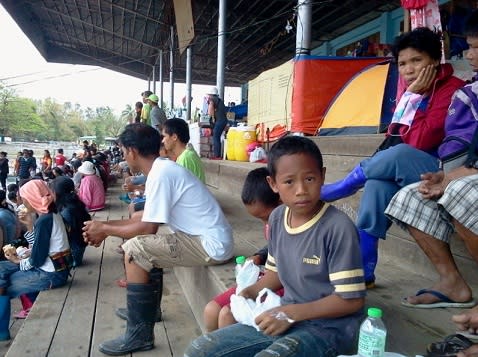Hope rises from the rubble of ‘Pablo’

By Johnna Villaviray Giolagon, VERA Files
NEW BATAAN, Compostela Valley—As heart-wrenching as the devastation, is the survivors will to rise from the rubbles of what was once their homes.
“BABANGON TAYO! NEW BATAAN” is prominently painted on a mud-stained wall near the municipal hall.
Their needs are so simple and they can even afford to share in their time of want.
At the basketball court, 21-year-old Apple Grace Solmeron carefully made her way across the rain-drenched floor carrying 13-month-old Johann. She is among the scores of evacuees that spent Christmas here ---and most likely the New Year, too.
“We’re lucky because we are all safe. We have enough food and other things that we need, but I really wish we could spend the holidays in our own home,” said Apple Grace, who is expecting her second child in eight weeks.
Across the road in the grandstand, 52-year-old Luna Sumampong mirrored the young mother’s wish to be able to rebuild a home.
“They (displaced) are now very eager to return home and rebuild their lives. The only question is when they can go and where,” said New Bataan parish priest Fr. Edgar Tuling.
The Department of Social Welfare and Development has begun building temporary bunk houses where the displaced can stay until a more permanent shelter is made available for them.
Fr. Ed noted that New Bataan appears more organized than other areas hit by the typhoon. People from outside town are even coming in to partake of relief goods.
“We receive so much and it’s only right that we share what we have,” he said. “That is the Christian way.”
It was as if Armageddon came to pass on Dec. 4 in this mountainside village, days before the dreaded end of the Mayan calendar. (In the Bible, Armageddon is the final battle at the end of the world between the forces of good and evil.)
Ushered by super typhoon Pablo (international name Bopha), winds that reached 185 kph uprooted trees, flattened banana and coconut plantations and blew away rooftops.
A flash flood from where locals call White Peak unleashed rampaging waters that devoured whole families and communities. Nothing was left but boulders, rubble and broken dreams in its wake.
Remegio Donato, a 44-year old church volunteer, paused from the task of sweeping mud and clearing debris from the Catholic chapel to survey the damage caused by the flash flood in Barangay Andap.
Looking out at what appeared to be a dry river bed, Loloy—as friends and family call Remegio—recalled that a residential neighborhood stood in the area before the disaster. It was where his parents and his brother’s family lived.
“Wala na (They’re all gone),” Loloy said with an impassive face, his arms crossed over his chest.
His 68-year-old mother was receiving first aid at the health center when the flash flood struck. The door had smashed into her hand as she gripped the door jamb for support against the whipping winds.
Pablo killed a total of 1,067 individuals in the five days the typhoon devastated Mindanao. Some 834 more people—including Loloy’s parents, his niece and her three-year-old daughter—remained missing in Pablo’s aftermath.
Loloy’s brother survived the flash flood but later succumbed to tetanus due to untreated wounds and scrapes sustained battling the current.
Some 2,666 persons suffered injuries due to Pablo, which affected 711,682 families or over 6.2 million individuals.
Pablo is considered the most devastating typhoon to hit the country since 1970 with damage to property reaching P36.9 billion.
For people like Loloy, the damage is all too real. He lost his house; coconuts and other fruit trees planted in the mountains were all uprooted; the farm he worked for part-time was washed away.
Some 235 families are currently huddled in makeshift evacuation centers like the typhoon-damaged covered basketball court and the elementary school grandstand in New Bataan town proper. A total of over 4,000 families were rendered homeless by Pablo.
Although the entire town is without electricity or running water, it appears it is not without hope.
“Immediately after the tragedy, people were understandably in shock. Many can’t sleep, talk or even cry. They would scramble for food because they didn’t know if the food assistance would be enough for everybody,” acknowledged Social Welfare regional director Pricilla Razon.
“(But) now, order has been established. People don’t fight over the relief assistance because they know there is enough,” she continued amidst an assortment of relief goods like bottled water and some non-food items.
As of December 27, DSWD records show that cost of assistance to 204,464families affected by Pablo has reached P175million. The government assistance includes P44 million worth of family food packs.
Assistance from the World Food Program (WFP) is allowing government to allocate as much as 10 kilos of rice per family as well as other food items and supplements.
WFP deputy country director Asaka Nyangara acknowledged that the actual pledges and donations that have come in remain way below the target.
As it is, food supplies are enough to feed the displaced for three months. Beyond that point, authorities will need to sanitize the list to make sure that the neediest is prioritized.
(VERA Files is put out by veteran journalists taking a deeper look at current issues. Vera is Latin for “true.”)




